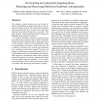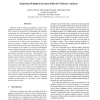38 search results - page 7 / 8 » Detecting Trojan Circuit Attacks |
SP
2010
IEEE
13 years 9 months ago
2010
IEEE
The computer systems security arms race between attackers and defenders has largely taken place in the domain of software systems, but as hardware complexity and design processes ...
ISQED
2010
IEEE
13 years 7 months ago
2010
IEEE
Recent studies have shown that an attacker can retrieve confidential information from cryptographic hardware (e.g. the secret key) by introducing internal faults. A secure and re...
SP
2007
IEEE
13 years 11 months ago
2007
IEEE
Malicious code (or malware) is defined as software that fulfills the deliberately harmful intent of an attacker. Malware analysis is the process of determining the behavior and ...
VIROLOGY
2010
13 years 3 months ago
2010
Abstract. This paper gives an overview of our research in the automation of the process of software protection analysis. We will focus more particularly on the problem of obfuscati...
ESORICS
2010
Springer
13 years 6 months ago
2010
Springer
Abstract. We introduce a novel remotely-mounted attack that can expose the network identity of an anonymous client, hidden service, and anonymizing proxies. To achieve this, we emp...


